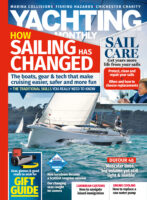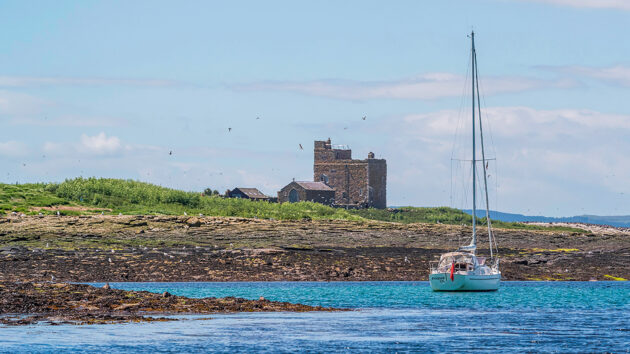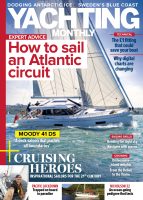Each month Yachting Monthly's new resident expert, Rachael Sprot answers a reader's question. This month will this anchorage be safe to stay in overnight?
Louise and Julia are cruising the north east of the UK on their Grand Soleil 43. They seize a brief weather window to visit the Farne Islands off the Northumbrian coast.
With light southwesterlies, The Kettle, the small bay on the western side of the islands, is unsuitable, but the large bay opposite it – Newbiggin Bush, between the Wideopen Islands and Knoxes Reef – offers a good alternative. They arrive at 1600, which is LW, and find good shelter inside a horseshoe of islands and reefs. The anchor sets perfectly.
The pilot describes it as a daytime stop only, so they had intended to sail on before dusk. However, it’s such a peaceful spot that Louise suggests they spend the night. If, at any point they feel uncomfortable, they have an easy exit to the east into Staple Sound, and with offshore winds they could relocate to one of the mainland bays instead.
They have a chartplotter by the helm and Louise enters a route just in case. By 1900 though, Julia notices that the reef surrounding the anchorage has already started to cover and becomes concerned that the anchorage will be exposed at high tide. The forecast is southwest F2-3, veering west overnight, and they’re two days off springs.
Should they stay or should they go?
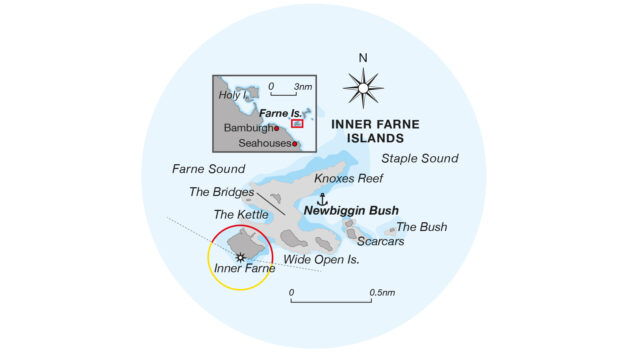
Will this anchorage be safe to stay in overnight?
The Farne Islands are a magical spot, an uninhabited bird reserve which was home to the 7th Century monk St Cuthbert, who was bishop of Lindisfarne (or Holy Island).
Having worked hard to get to a remote spot like this, it’s often tempting to stay longer if the conditions allow.
There are a few alarm bells ringing though. The forecast is light, but it’s not entirely settled. Whilst they’ll have some protection from the west, it’s hard to know how much of the reef ahead of them, The Bridges, will uncover. Furthermore, if Knoxes Reef to the north covers, they’ll find themselves exposed to the south-going flood stream, which reaches 4kn at springs through Staple Sound. This would put them in a vulnerable position being set towards the islets to the south. Although the anchor is holding now, if they become tide-ridden it might drag or trip.
Louise’s observation that they have an easy exit is true during the day, but by night the rocks are completely unlit with no useful contours to warn of an impending encounter.
They’d be heavily reliant on the chartplotter to monitor for cross tide. Whilst the chances of GPS error are low, relying solely on one source of position information is always risky, and staring at the screen in the dark can be very disorienting, especially if leaving in a hurry. There’s also the ever-present risk of lobster pots on this coast.
If the conditions were completely settled and it was neaps, they’d stand a better chance of a quiet night, but I’d be reluctant to venture outside the pilot guide’s advice in an unfamiliar area. This dilemma comes down
to not knowing how the anchorage will change through the tide. If they’d been there through the previous high water and assessed the conditions, they’d be better placed to make an informed decision (and would probably have found it untenable).
There are times for opportunism when cruising, but this isn’t one of them. In my experience with remote anchorages, it’s better to heed the warning signs and leave on your own terms, than wait for your suspicions to be confirmed.
Enjoyed reading this?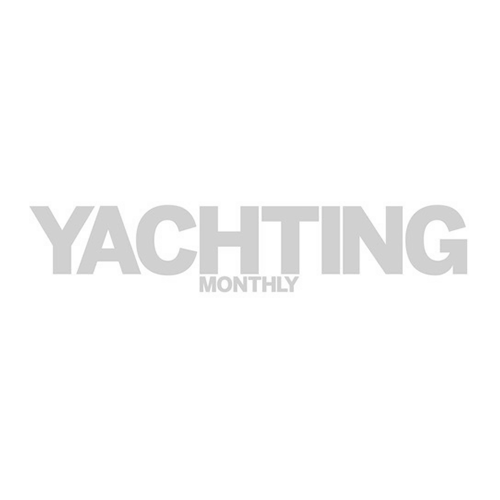
A subscription to Yachting Monthly magazine costs around 40% less than the cover price, so you can save money compared to buying single issues.
Print and digital editions are available through Magazines Direct – where you can also find the latest deals.
YM is packed with information to help you get the most from your time on the water.
-
-
- Take your seamanship to the next level with tips, advice and skills from our experts
- Impartial in-depth reviews of the latest yachts and equipment
- Cruising guides to help you reach those dream destinations
-
Follow us on Facebook, Twitter and Instagram.
Note: We may earn a commission when you buy through links on our site, at no extra cost to you. This doesn’t affect our editorial independence.

